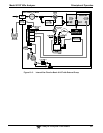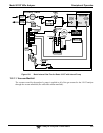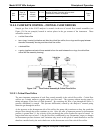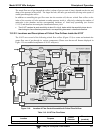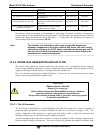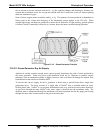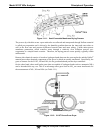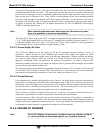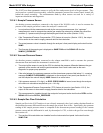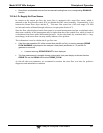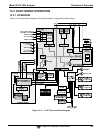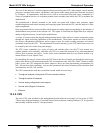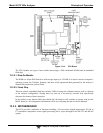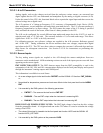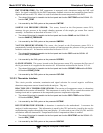
Model 9110T NOx Analyzer Principles of Operation
Teledyne Analytical Instruments 335
To provide a dry purge gas for the outer side of the Nafion tube, the 9110T returns some of the dried air
from the inner tube to the outer tube. This means that any time the analyzer is turned on after having
been OFF for 30 minutes or more, the humidity gradient between the inner and outer tubes is not very
large and the dryer’s efficiency is low. Since it takes a certain amount of time for the humidity gradient
to become large enough for the Perma Pure
®
Dryer operate efficiently, in such cold start cases the O
3
Generator is not turned on until 30 minutes has passed in order to ensure that it is not operating until its
air supply is properly dry. During this 30 minute duration the O3 GEN OVERRIDE menu displays
“TMR” on the front panel screen.
Note When rebooting the instrument within less than 30 minutes of power-
down, the generator is turned on immediately.
The Perma Pure
®
Dryer used in the 9110T is capable of adequately drying ambient air to a dew point of
≤ -5˚C (~4000 ppm residual H
2
O) at a flow rate of 1 standard liter per minute (slpm) or down to ≤ -15˚C
(~1600 ppm residual H
2
O) at 0.5 slpm. The Perma Pure
®
Dryer is also capable of removing ammonia
from the sample gas up to concentrations of approximately 1 ppm.
13.2.3.3. Ozone Supply Air Filter
The 9110T uses ambient air as the supply gas for the O
3
generator and may produce a variety of
byproducts. Small amounts of water, ammonia and various sulfur oxides can combine to create
ammonium sulfate, ammonium nitrate, nitric acid and other compounds. Whereas sulfates and nitrates
can create powdery residues inside the reaction cell causing sensitivity drift, nitric acid is a very
aggressive compound, which can deteriorate the analyzer’s components. In order to remove these
chemical byproducts from the O
3
gas stream, the output of the O
3
generator flows through a special filter
between the generator and the reaction cell.
The small amount of NO
X
produced in the generator (from the reaction of O
2
or O
3
and N
2
in the air) will
not affect the 9110T’s ability to measure NO
x
, NO and NO
2
as it is accounted for and removed from the
concentration calculations by the analyzer’s Auto Zero feature (see Section 13.1.4).
13.2.3.4. Ozone Destruct
Even though ozone is unstable and typically reacts to form O
2
, the break-down is not quite fast enough to
ensure that it is completely removed from the exhaust gas stream of the 9110T by the time the gas exits
the analyzer. Due to the high toxicity and reactivity of O
3
, a highly efficient catalytic converter scrubs or
converts all of the O
3
from the gas exiting the reaction cell. The conversion process is very safe. It only
converts ozone to oxygen and does not produce any toxic or hazardous gases.
The O
3
destruct is located just inside the NO
2
converter. As this is a true catalytic converter, there are no
maintenance requirements as would be required for charcoal-based ozone destructs.
A certain amount of fine, black dust may exit the catalyst, particularly if the analyzer is subjected to
sudden pressure drops (for example, when disconnecting the running pump without letting the analyzer
properly and slowly equilibrate to ambient pressure). To prevent the dust from entering the reaction cell
or the pump, the ozone destruct is equipped with a quartz wool filter material.
13.2.4. PNEUMATIC SENSORS
Note The 9110T displays all pressures in inches of mercury absolute (in-Hg-A),
i.e. absolute pressure referenced against zero (a perfect vacuum).



